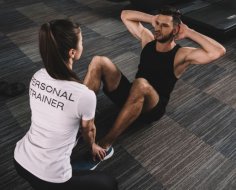
Few would dispute that defined abs look beautiful. At least on men. It's more complicated with women—many believe any visible muscle immediately makes them look like the Terminator. Which is a shame. Because defined abs are not only beautiful (yes, on women too!), but also healthy.
Firstly, it supports the abdominal organs. Secondly, it protects them. Thirdly, it helps stabilize the body's posture and form its proper structure.
It's no coincidence that the abdominal muscles are one of the body parts that receives special attention in training. However, this doesn't stop many myths about abdominal training from persisting.
Let's start at the beginning—with the most common situation: looking in the mirror one day and deciding to “get ourselves in order.” How? Two, perhaps the most popular, methods: running and “abs.” The first is usually considered the simplest and most effective weight loss method; the second is designed to “flatten the belly.” That's what we're talking about.
The most popular exercise among the people is crunches or sit-ups while lying on your back. If this doesn't help (and it often doesn't), the most persistent “enhancers” the effect by exercising on an incline bench. Often, this is just as fruitless.
In fact, there are results. They're just not as pronounced. Your abdominal muscles become stronger and more resilient; you might even see abs appearing. They're there, but they're not necessarily visible, remaining hidden beneath a layer of fat.
And this is the first and most obvious reason for the appearance of a belly. It's not the main one, but it's usually what people try to get rid of first.
Just doing crunches won't help here. Fat deposits are a reserve source of energy, which the body will only use when there's a shortage of familiar and more readily available food.
In other words, without an energy deficit, it's impossible to lose fat deposits. A deficit is achieved either by reducing intake or increasing expenditure, or both. Otherwise, the body simply won't use up the reserves accumulated for a “starvation year.”
Localized exercises that target individual muscle groups won't create the required energy expenditure, and therefore, an energy deficit. No, aerobic, strength, or interval exercises are needed. These should be performed at high intensity and exertion, like interval and strength exercises. Or over a long period of time, like aerobic exercises.
On the other hand, creating a carbohydrate deficit is essential. At a minimum, you'll need to avoid increasing your carbohydrate intake as you increase your intensity . Otherwise, you might find yourself compensating for all the calories you've burned by eating after your workout. And there's an excuse: you're working out now! You're expending a lot of energy! Which means you need to eat well…
Don't be surprised if, with this approach, your fat reserves don't disappear. In fact, they might even start to replenish.
Well, if you follow the rules, attacking from both directions— increasing the load while reducing the intake of calories and, above all, carbohydrates —your belly will shrink without any special emphasis on abdominal training.
But even this doesn't always help. It's not uncommon for a protruding belly to appear in a person who isn't overweight. Perhaps the “treatment” is ineffective because the “wrong medicine” is being used? Or more accurately, “for the wrong reason”?
Have you ever been told in gym class or in the army something like, “You've got that loose belly! Pull yourself up!”? That's another reason. No, we wouldn't call it “looseness.” Let's put it another way: the muscles aren't toned. Sure, they might just be weak—but didn't we strengthen them by trying to burn fat?
But having strong muscles isn't enough. Take a look at bodybuilders: are their obviously strong muscles tensed in everyday life? No. And while they're voluminous, they're nowhere near as impressive as they are in competition. And the reason is clear: they're relaxed.
But, for example, the biceps don't need to be constantly supported. But the abdominal muscles do, as they contain the abdominal cavity. And they need to stabilize their vertical position. In other words, the abdominal muscles are almost always involved in one way or another.
This is often where the cause of a bulging or sagging belly should be sought. So, does that mean you need to tighten your belly only to maintain muscle tone?
It's not that simple. Some people try to keep their stomachs completely sucked in. The results are, at best, zero. In the worst-case scenario, this position can lead to respiratory and circulatory problems. Or, depending on how you suck them in, to more than just the circulatory problems!
Meanwhile, the folk wisdom I dislike is right in this case, giving a very clear instruction: “Pull up!” Not “pull in your stomach,” but “pull up.” Remember how we said that localized exercises for the “problem area” won't help us lose weight, but will only pump up our abs? The same is true here.
Don't try to pull in a local part of yourself. This will only last for a short time, just until you're distracted. Instead, we “pull ourselves up.” Completely, with our entire body. The head “hangs” by the crown, and the entire spine “pulls” up with it. Elsewhere, relax and bend the knees slightly, keeping the feet parallel and pointing straight ahead. The lower spine “stretches” a little more, this time downwards.
Avoid tension, there shouldn't be any here!
The posture becomes relaxed and straight, the chest “rises” and the stomach goes “inward”.
You can similarly align your body by standing with your back to the wall, touching it with your heels, buttocks, shoulder blades, and the back of your head. Hold this position, noticing the sensations in your body. After a minute, step back, trying to maintain a straight posture as much as possible.
And as long as our posture remains more or less straight, our belly will be smaller. Even a fairly large belly will “shrink” and, most likely, visually tighten.
And the more often you repeat this “alignment,” the greater the chance that posture control will become spontaneous, automatic, habitual, and, finally, natural.
Of course, everything said here applies to healthy people, with normally functioning muscles, not damaged by injuries, operations or diseases, and their normal innervation.
To make sure of this, first of all, before starting any exercises, you should visit a doctor.






